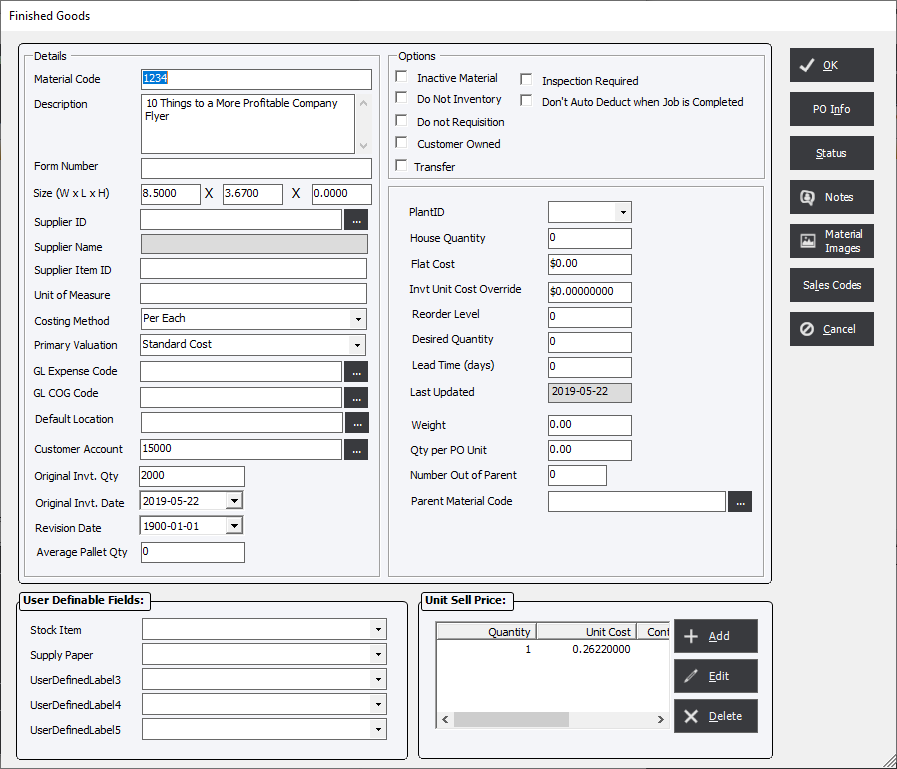Add/Modify Finished Good Item
Updated September 5, 2024
Click Add or Modify to create or modify a Finished Goods item and the system will display the Finished Good screen.
Finished Good Item

Details
Code : A unique alphanumeric code to identify the material.
Description : Enter a description for the Category.
Form Number : (Informational) - Enter an alphanumeric, if applicable. NOTE : This Form Number is NOT related to the Form Number on the Header Screen.
Size (W x L x H) : These dimension fields may be used to record the size of the item. This would be beneficial if there are several items with a similar description.
Supplier ID : Select a Supplier from the drop-down list.
Unit of Measure : This field allows the user to define a unit other than each to be used when creating an order (e.g. carton) and is usually tied to the Qty per PO Unit field below.
Costing Method : Select a costing method, for Finished Good Items the Costing Methods are restricted to either Per M or Per Each.
Primary Valuation : Select an inventory valuation method, either Standard Cost, LIFO, FIFO or Average Cost.
GL Expense Code : Allows the user to default GL Codes (both Integrated and Non-Integrated Accounting) that will populate the fields in a Purchase Order when a new PO Line Item is created for that Material.
GL COG Code : Allows the user to default GL Codes (both Integrated and Non-Integrated Accounting) that will populate the fields in a Purchase Order when a new PO Line Item is created for that Material.
Default Location : To be used as a default to populate transactions such as Allocations, Deductions, Adjustments, Transfers and Receipts
Customer Account : Select a customer if the item is specific to a single customer. If the item is associated with a specific customer, then the item will only be available, in Estimating/Order Entry, when that customer is selected.
Original Invt. Qty : (Informational) - The value entered has NO affect on the Quantity on Hand for the Item. It is strictly for informational purposes.
Original Invt. Date : (Informational) - When a new Item is entered the system will default this field to the current date. However, the user has the ability to change the date at any time.
Revision Date : (Informational) - When a new Item is entered the system will default this field to the current date. However, the user has the ability to change the date at any time.
Average Pallet Qty : (Informational) - This field can be included on a custom report but it has no affect on any calculations throughout the system.
PlantID : Used for Multiplant installations.
House Quantity : (Informational) - Represents a quantity that may be added to a replenishment order to provide a hedge in the event that the customer will require an urgent, unplanned shipment or as a hedge against inventory shrinkage.
Flat Cost : This value will be added to any calculated cost.
Reorder Level : Enter the lowest inventory level below which the item should be re-ordered.
Desired Qty : Enter the optimum inventory level that will be desired .
Lead Time (days) : (Informational) - The "Lead Time" field is for information only.
Last Updated : (Informational) - This field indicates when the record was last modified. Not an editable field.
Weight : (Informational) - The weight of a Finished Goods Item may be entered in this field that will assist in determining a shipping cost but has no affect on any process or material calculations.
Qty per PO Unit : This field operates in conjunction with the Unit of Measure field. Qty per PO Unit defines how many items will be included in the unit of measure (e.g. 100 items per carton).
Number Out of Parent :
User Defined Fields : Customization fields.
Unit Sell Price : Allows the user to create a grid for selling and purchasing the item.
Options
Inactive Material : If this option is selected, the user will be blocked from entering transactions for these items in estimates, orders and purchase orders. For estimates and orders that already include inactive materials in them, the system will display a warning when the estimate or order is accessed. A pop-up list will display which materials are inactive.
Do Not Inventory : The Quantity On Hand value will not be maintained for this Item but the Item will be accessible through the system.
Do Not Requisition : If selected, the user will not be able to create a purchase requisition for an Order for this item.
Customer Owned : Select this option if the item is owned by the customer.
Transfer : This field is used in conjunction with 3rd Party Web-to-Print solutions in order to indicate which Finished Good Items should have their Quantity On Hand balances synced.
Inspection Required : (Informational) - Used primarily for Custom Reports to indicate that a Material should be inspected when received.
Don’t Auto Deduct when Job is Complete : This option works in conjunction with the System Setting Auto Deduct Inventory when Job is Completed and a material to be exempt from a Deduction entry being automatically created when the Job is completed.
Buttons:
PO Info : The system allows the user to purchase a material using one costing method (e.g. “Drums, Rolls”) and to inventory the same material using a different costing method (e.g. Pounds, MSI, Linear Feet).
Status : View the inventory status of the item.
Notes : Allows the user to add relevant information to an Item that will be available to display in an Estimate or Order.
Material Images : Allows the user to link an image to a Material. This image will also be used to display online in the MyAccounts web portal if owed/used.
Sales Codes : PO Info